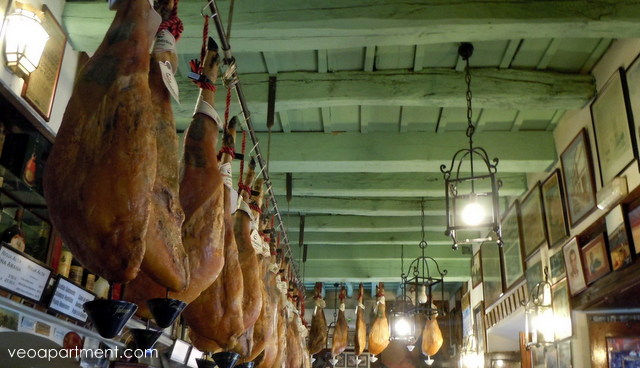
If you’ve ever been to Spain, and been out for tapas, you have probably already sampled the delights of genuine Spanish Iberico ham for yourself, and discovered its unique slightly nutty, slightly sweet taste (and if you haven’t it’s almost worth making the trip for this alone). Either way, though, you may have asked some “meaning of life” style questions, such as, What’s the difference between Iberico and Serrano? What’s the significance of bellota (pronounced bayota)? How do they make this wonderful stuff? And Can I have some more, please? Well we’re going to answer these questions for you. Except the last one – you can ask the barman.
The Pig, The Whole Pig, and Nothing but the Pig
While both Iberico and Serrano (literally mountain ham) are both free range cured pork, Iberico refers exclusively to products made from the native Spanish black pig (also known as pata negra), which has been around in Spain at least since the stone age, while Serrano is usually made from the European white pig. The Iberico is considered superior for cured meats because its higher fat content, especially on the outside of the ham, allows for longer curing and a richer flavour.
Bellota and the Dehesa
Bellota is Spanish for acorn, and the appearance of this term in the name tells you that this came from a free-range pig fattened on acorns, which is the key factor in giving the fat in the meat its melt-in-the-mouth quality. It also makes it very healthy, as it’s rich in oleic acid, the oil that you find in olives. The Dehesa is the open hillside pasture land, studded with oak trees, mostly holm oak and cork, where the pigs are turned out to forage and fatten about six months before slaughter. To ensure room to roam and plenty of acorns, pig populations are limited to just two per hectare. This also limits supply, and helps keep prices, as well as pigs, healthy. Maintaining this high quality through all the stages of production is the responsibility of the controlling bodies of the four Denominaciones de Origen (D.O.s). The main production areas are in Extramadura, Huelva and Seville in the southwest of Spain, and in recent years tours of the farms and the Dehesa to see the pigs have become increasingly popular.
Curing
After the slaughter, or matanza, in January or February, the parts of the pig that are to be cured – the legs, of course, but also other cuts, including those used to make caña de lomo – are separated and buried in salt for two to three weeks, and then hung up to dry in the mountain air in special warehouses. The curing process lasts for around two years, and sometimes longer. The hams may lose up to half their weight as the fat sweats out of them (which is why you often see those little cups under the hams hanging up in bars), while the salt prevents bacteria from attacking the meat. Natural antioxidants in the meat also help to break down the fats, giving it its unique texture and rich medley of flavours that increases with the length of the curing process. And there you have it!
Where you can find it
You can find it in almost any bar, and it’s actually a good idea to try a tapa or ración of Jamón Iberico de Bellota at several different establishments as every jamón experience is a little bit different. Not only does the quality vary from place to place, but so does the cutting technique (there are actually competitions) and, of course, you will be getting meat cut from different parts of the leg. The meat should be eaten at room temperature and accompanied by a fino or manzanilla sherry. Que aproveche.